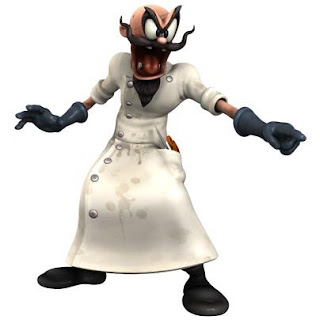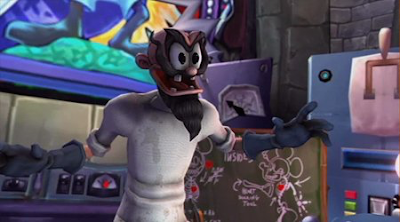Other Names: The Evil Queen, the Wicked Witch, the Old Peddler, Queen Grimhilda
From: Queen Grimhilde, as all of you probably know, was the main antagonist of the first-ever full-blown animated film produced by Disney in 1937, Snow White and the Seven Dwarfs. After that, her Wicked-Old-Witch self was transferred to the comics, where she enjoyed a long, if not very memorable career as a very toned-down antagonist for the Seven Dwarfs or even to Donald Duck or Uncle Scrooge (during this period, her past as a Queen was hardly referenced at all); one of her most enjoyable performances in this role might be in The Washed-Up Witch, an intentionally silly but masterfully-drawn story where she antagonizes Scrooge and, believe it or not, actually reforms at the end. In the Italian branch of Disney comics, an incarnation of the character much closer to the 1937 film antagonized the Dwarfs and Snow White in long serials, most of them written by Guido Martina and drawn by Romano Scarpa, such as The Seven Keys of Danger, which you can actually read a professional-level translaiton of here. She was also the villain protagonist of Once Upon a Halloween, a shameful merchandising direct-to-DVD spin-off of the Disney Villains franchise.
Description: As keeps being the case for those early villains, Grimhilde went through several different incarnations. Her first is, of course, the character in the 1937 movie. In it, the Queen is an extremely beautiful but also vain queen ruling over a small fantasy country. She was the second wife of the good King, who had already had a daughter, Snow White. The King died a short while later (which was quite possibly Grimhilde's doing — it was explicitly so in early scripts), leaving Snow to grow up alone in the castle. Meanwhile, we also know that the Queen is in fact a terrible sorceress: she keeps a secret magic lab under her castle and owns a Magic Mirror, which she can use to summon an all-knowing (and pretty creepy) Spirit. Though her wicked ways are well-known throughout her kingdom, her witchcraft is the very thing that allows her to remain in her position of power.
Interrogating the Mirror.
However, her vanity is also her undoing. When the Spirit in the Magic Mirror tells her that Snow White, now a charming young girl, has become the fairest in the land, Grimhilde resolves to have her killed by her huntsman, Humbert; the comics mention that Humbert is forced to obey her, lest she exectues his wife and children. However, the good man cannot bear to do it and tells her to flee into the forest while he arranges for it to look like as though he had completed his mission. Obviously, since the Queen has that all-seeing Mirror we told you about, this fails, and the Queen decides to go murder Snow White off herself. To have "the perfect disguise", the paranoid and increasingly insane Grimhilde uses her magic to turn herself into an old ugly peddler, as nobody would recognize the most beautiful and powerful woman in the land under such a guise, and goes off to the Dwarfs' cottage where Snow is hiding, intent on getting her to bite a poisoned bewitched apple. She succeeds, and, ironically, exclaims that she is now "the fairest woman of all times" whilst an ugly, wrinkled, skeletal old woman. The sort-of-sentient forest animals that Snow White befriended earlier, however, manage to rally the Dwarfs, who chase the helpless old woman up a mountain. Realizing she is now trapped at the top in front of a gaping ravine, she pulls her trump card and tries to send a gigantic rock to crush down the dwarfs. She is struck by lightining before she can do so and falls off to her demise.
Moving on… in the Martina/Scarpa comics, we see that the Queen has managed to survive the fall, but comes back too late to her castle, only to see that Humbert has burnt it down, hoping to end her tyrannic rule. By the time she retrieves enough witchy ingredients to regain her magic powers and her true beautiful form, Snow White, the Prince and the rest have settled in as the new rulers of the country and exposed her tyranny. Now crazier and eviler than ever, the Queen remains bent on killing Snow White and the Dwarfs, out of pure revengefulness, which she tries to achieve through increasingly crazy and devilish curses. Something close to this version of the character also made a couple of insubstantial appearances in American Disney comics in the 40's.
Grimhilde in “The Washed-Up Witch”.
Finally, here is the 1950's American comics Wicked Witch. How she ended up living as your typical old witch in a cottage in the woods is never really explained ("Hey, what small kid is going to notice and complain?"), but she is now a recurring antagonist for… well, just about anybody, in fact. Her victims of choice are of course the Seven Dwarfs (though rarely Snow White herself, who hardly ever appears at all), but she also helps the Big Bad Wolf to catch the pigs, schemes with an assembly of Disney villains ranging from Captain Hook to the Beagle Boys, or hangs around Duckburg causing small-scale chaos for the sake of it. In most of her appearances, she is a very one-dimensional villain who is just about your typical fairy tale witch who's evil and has magic powers because, well… because, that's why, now go to bed. However, some of the writers assigned to work with this character sometimes made fun of her toned-down aspect, and nowhere is this so apparent as in The Washed-Up Witch, where she is just what the title says — old, tired, and simply all-around done with it all. She still believes herself to the prettiest in the land even though flowers wilt at her mere presence, and always appreciate someone treating her gentlemanly; when she is tricked into believing her magic powers have completely faded away, she is quick to adopt a job as Scrooge McDuck's secretary and stroll off into the sunset singing a merry song. No, really.
Review: The movie incarnation of Grimhilde was fascinating, beautifully animated and threatening. Her barely-hinted-at backstory (Magic powers? How? She seduced Snow's dad? How? She brought about a rule of tyranny? How?) is extremely intriguing, and she is extremely impressive and ominous in all the scenes she's in as the cold-hearted and disturbingly pretty Queen. As the Witch, her slow descent into madness is also very compelling to watch. She was the first really serious Disney antagonist, and she was a masterpiece as far as this kind of villain is concerned.
The Martina/Scarpa Queen Grimhilde was sort of a toned-down version of the movie Grimhilde; in her actual appearances, the writers were mostly relying on the readership's memories of her role in the movie to be interesting, with very little added to her character or psychology. However, she made up for it with a massive power upgrade turning her into a perfect shapeshifter able to conjure up entire magical mazes, dragons, and all sorts of similar awesome things. She was more of a plot device than a character, but she was a darn impressive plot device.
The straight-played 50's Wicked Witch is not all that interesting — just the old fairy tale Wicked Witch, and not a terribly interesting specimen at that. Disney comics have two other "typical fairy tale witches" as regulars, Witch Hazel (who is mostly good) and Madam Mim (who is mostly evil bordering on neutral), both of whom are much more entertaining. However, the "Washed-Up" version is charming and hilarious in its own unique way; maybe it wouldn't have held on for a long run, but her roles in Washed-Up Witch and the handful other stories that used this version was a delight.








